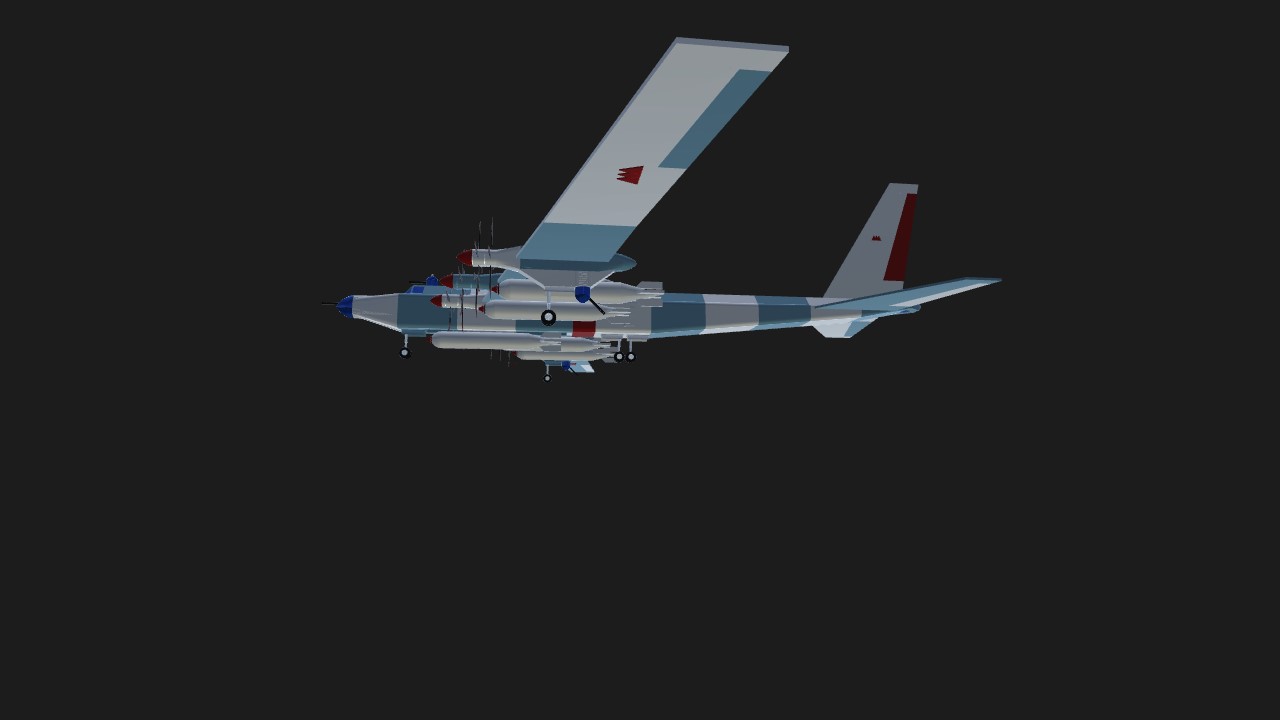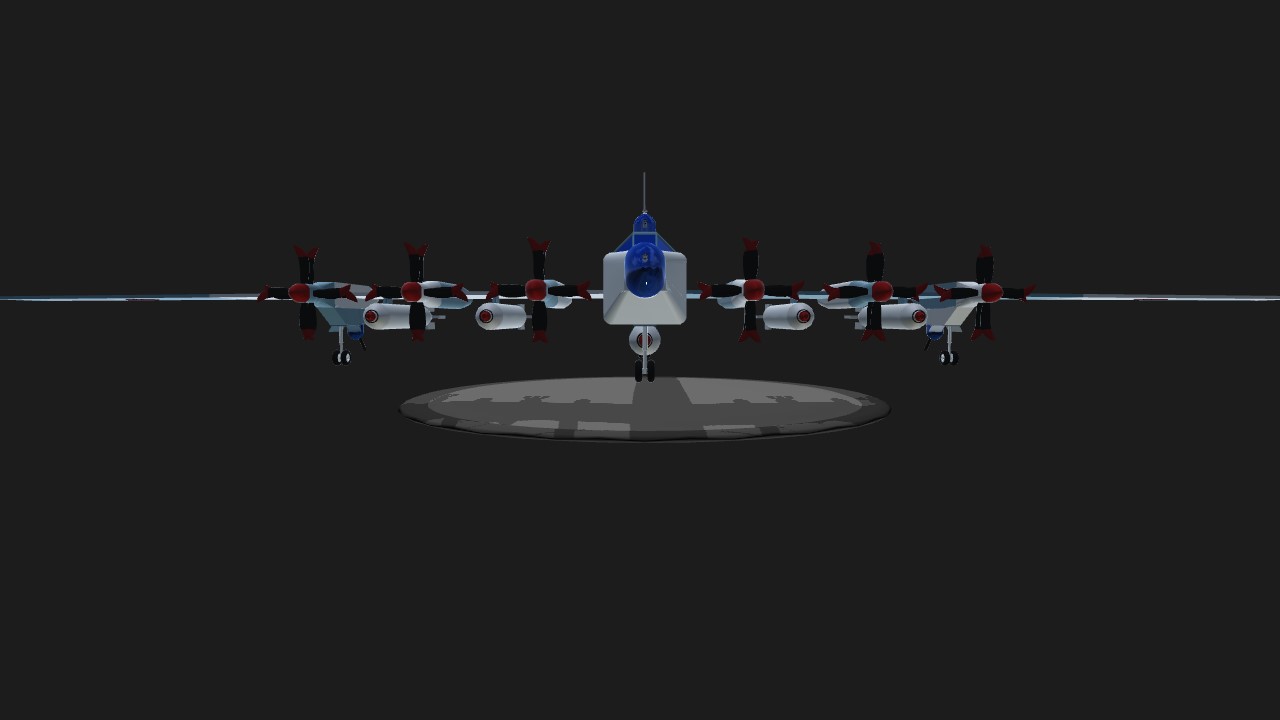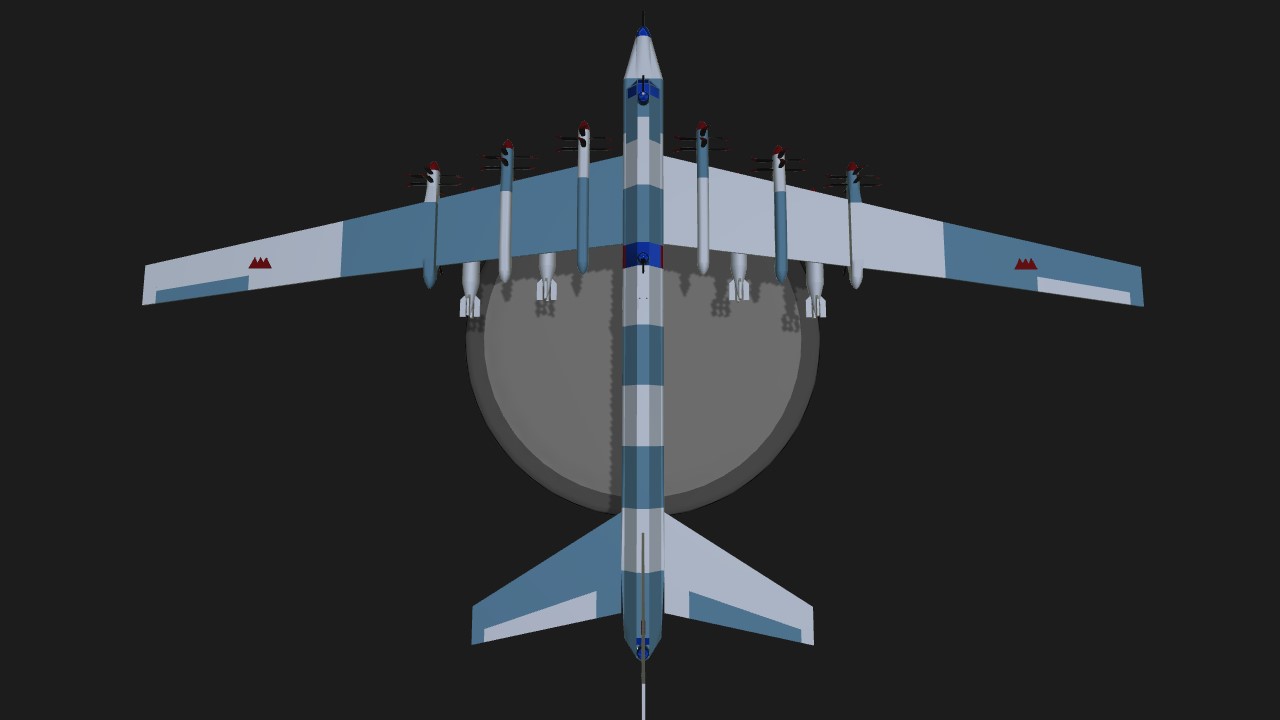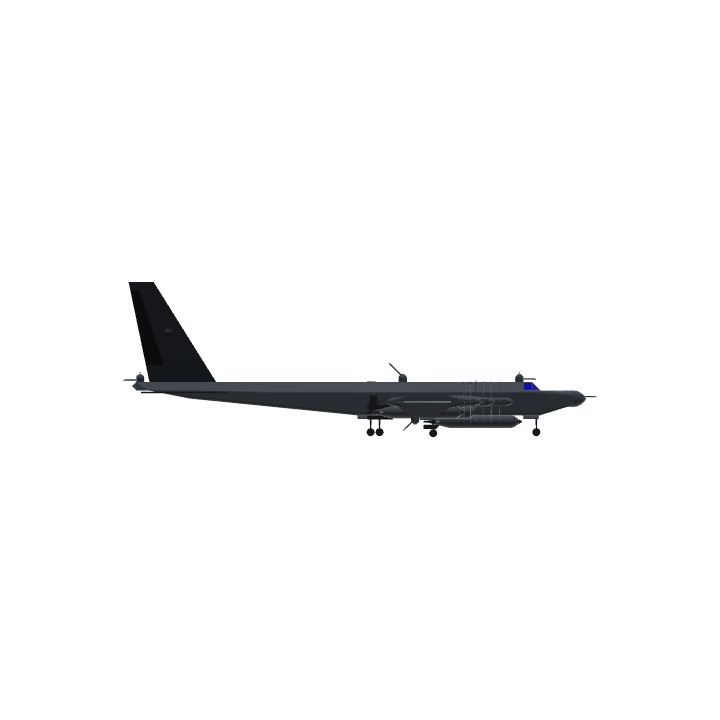While only a vague concept at the time of the capitulation of The United Kingdom of Sweden & Norway what research had gone into designing a heavy strategic bomber fell into Se Suomi Imperiumi's hands once SAAB was absorbed into Suomi Imperiumi Lentokonetehdas (Finland Empire Aircraft Factory.) While still toying with underpowered, inefficient centrifugal jet engines and gliders for their jet fighter programs, the Model 23 program carried on with the utmost priority in the mid-40s. Completed in 1952 it became one of the largest heavy bombers to enter the service of any country. Mostly retained as a deturant against their traditional rival and rare ally, Imperial Russia, their bomber fleet had seldom been over the Baltic Sea thus it was largely unknown to any but the Britannic Empire and was suspected by Imperial Russia.
When Das Germanishe Weltreich (The Germanian Empire) began deploying Fuel Air Explosive and Napalm attacks against communities in Suomi it automatically kick started Prince Juho's plans into phase two, in which 74 of their SILK-234s Sinitaivus Linna would begin high altitude bombing air strikes against industrial and military targets in continental Germania after rendesvousing with their fighter escort out of bases in southern Suomi proper.
This bombing campaign came as a complete surprise to Germania. Not only did their escorting fighters outperform their own but they learned the meaning of this aircraft's moniker if not its actual name - Sinitaivus Linna - or literally Sky Castle, due to it's impressive defensive weaponry. After the first week of the bombing campaign many Germanian pilots outright refused to engage the bombers and their escorts suffering severe punishment as a result. Others flew their aircraft into the neighboring Kingdom of Belgium, a neutral nation, where they and their aircraft would be inturned until the end of the conflict.
CG 1 - Activates the air breaks; The Model 23, version 4 is remarkably fast thus they are useful on approach as well s once the wheels are on the ground. Raise and lower them with the VTOL slider. (Deactivate when not in use!)
CG 2 - Arms the pilot's forward facing 20 mm cannon in the nose glazing over the bombardier's position.
CG 3 - Notifies all defensive gunners to arm their weapons and fill the sky with jacketed lead and tracers. Use the VTOL slider to manipulate all of the turrets at once! Note - make certain the gear is retracted prior to use.
CG 4 & 5 - Each drops a pair of 2,000 Lb. bombs!
CG 6 - Drops the solitary central 2,000 Lb. bomb in the recessed bay in the belly designed for oversized ordinance. While Suomi incidentally acquired the research data to develop Fuel Air Explosive weapons they have not fielded them in large scale against Germania save for remote military encampments/bases. The philosophy of the ruling elite of Se Suomi Imperiumi regarding brutal attacks on civilian centers is thus; Why kill a future subject to the "Scarlet Crown?"
Specifications
General Characteristics
- Created On Windows
- Wingspan 141.6ft (43.2m)
- Length 93.1ft (28.4m)
- Height 30.4ft (9.3m)
- Empty Weight 37,432lbs (16,979kg)
- Loaded Weight 80,187lbs (36,372kg)
Performance
- Horse Power/Weight Ratio 0.149
- Wing Loading 42.1lbs/ft2 (205.4kg/m2)
- Wing Area 1,905.9ft2 (177.1m2)
- Drag Points 12586
Parts
- Number of Parts 279
- Control Surfaces 5
- Performance Cost 1,521







@TheRubyArmy1134 Thanks for the upvote! ^_^
@MrMecha Ah yes, you can see the actual post-RP end comments below here. He was the other party in it and once I started releasing my own designs instead of just polishing up some very flawed designs he designated as the enemy and trying to explain why they bothered with them - the plug was pulled. This is where he expressed regret on that matter.
@MrMecha Thanks! Somewhat inspired by the Tu-16, though I didn't have the skill to quite make it look as good but dang this one performed well - though it lagged horribly.
@DragonAerotech I just feel like i may have pulled the plug to soon on it.
@DragonAerotech Alright, im thinking what if the nation of Suomi had started a revolt and reformed?
@TheOwlAce I went to sleep after my post got cut off and so didn't try to add in the data that was missing. In summary though what I wanted to illustrate was that the Luftwaffe and Luftstreitkräfte were two very different air arms. The Luftwaffe was a monstrosity created by the adversity laid down by the armistice, the various persons that rode into power on Hitler's coat-tails and through sheer experience - the Spanish Civil War, the Invasion of Poland, the Invasion of the Lowland Countries, the Battle of France and the Battle of Britain. This created a core of highly disciplined, skilled and experienced combat pilots in their various fields. They were hampered by their superiors due to their obsession/inflexibility when it came to battle tactics and as a result - the equipment provided to the front lines. (Small example being the He-177 Grief - the only truly heavy bomber to enter service with the Luftwaffe being hampered by unrealistic expectations for the power plants (causing numerous losses to in-flight fires) and the ludicrosity of them being reinforced and equipped to employ dive bomber tactics!
The Luftstreitkräfte I imagined for Germania though was still a battle hardened force from their experience during the Mediterranean War, described in one of my prior posts and more recently in their conflict in the Pacific against Imperial Japan. In terms of equipment I equate the Mediterranean War to the Spanish Civil War/World War II rolled into one due to its sheer scope and scale. I would have imagined that Germania would maintain a fleet of fighters, observation bombers, medium bombers, some strategic bombers and attack aircraft. The fighters could be broken down into fast point-defense aircraft that were intended to be used in a defensive role with limited flight time, tactical fighters with a slightly longer range and escort fighters OR heavy fighters. Meanwhile the Marine-Fliegerabteilung (Naval aviation branch) would maintain observation bombers, long range reconnaissance bombers and/or seaplanes, fighters (float or otherwise,) and finally your' airships.
I also thought you might have been referring to the aspect that Das Germanishe Weltreich (or Kaiserreich, if you prefer.) would not be caught unaware of Suomi's true capabilities - such as the SILK-234 here. I figured that they would likely be keeping their eyes on more immediate potential enemies such as Imperial France or the Empire of Britannia; After all, Se Suomi Imperiumi had never engaged in any direct conflict with Germania in history. (I drew this conclusion based upon the fact that during your' first wartime reports that the enemy was largely an unknown.)
I had to think of a reason why Se Suomi Imperiumi would choose this timeframe to engage a powerhouse like Germania. The answer came to me when I began to look at the history of the region that was considered Germania, the expanse that ethnic Germans covered and potential moves Germania might have made to ensure their own survival when surrounded by other powerful Kingdoms and Empires. Thus I guestimated that Germania would be composed of all of present day Germany, the area surrounding Danzig, Switzerland, Austria and likely Denmark as well as the Netherlands through conquest. (I drew this conclusion based upon the narrow channels that ensure Germanian access to the North Sea and from there to their colonial holdings. Prior to the Great War Germany possessed several colonies around the world - and by invading and conquoring the Netherlands would have inherited their' possessions as well.)
Thus I came to my conclusion as to why an opportunistic nation like Suomi would act against such a juggernaut; A conflict in the Pacific against Imperial Japan who had begun to expand to encompass the holdings of various European Empires. This would mean that a substantial amount of the military might of Germania would likely be in the Pacific theatre among a coalition of nations trying to repel the Japanese invaders and their allies. Then all Suomi would have to do is cough up a few odd occurrences that were reported, such as Germanian fighters using a regional airliner as a mock target, boarding vessels to inspect cargo and by careful political maneuvering could use this as justification in the world view to engage a preoccupied Germania in war to ensure their own sovereign rights while their actual goal was to absorb Germania in several stages while the bulk of their forces were away.
After all, I didn't want the nation my aircraft were to represent be one composed of idiots! lol
There was a lot more in the original posting with specific examples of how very different Germany would have been without the Third Reich, explaining the roles of different individuals in creating the Luftwaffe and so on but I'm -trying- to be brief.
Needless to say, I love history and imagining what might have happened had this event or that taken a different turn. ^_^
@DragonAerotech Holy crap.
@TheOwlAce Urgh. It cut my post off. -_-
@TheOwlAce You're referring to the refusal to engage, correct? An interesting fact behind the first heavy bomber to see combat in the Great War, the Ilya Mouromets. It actually gave the German Air Service a real hard time. Everytime they engaged them they took losses and thus pilots began to refuse to engage them as they were just too heavily defended. I took that page from history as I would imagined the German Air Service would still be much like it was during the Great War. Although the Bf-133 is a great fighter the newer types you introduced that were to replace it on a wide scale turned out to have some real issues that would have created a Great War-like environment where pilots feared their own aircraft as much as they did enemy gunfire.
The Luftwaffe, which you imagine a 1940-1960 air force to be, without the loss during the Great War, would be far different due to the conditions that created the Luftwaffe of World War II.
The post-war situation, where Germany was forced to hide their secretive and small air force, the experience gained in the Spanish Civil War, the reasonably ill equipped air arms of Poland, the lowland countries and the completely inefficient and ill prepared French Air Force created a battle hardened and disciplined Luftwaffe. Even the main individuals behind the creation of the Luftwaffe as history knows of it today were boosted to their positions of power by riding the coat tails of Hitler. Thus you have to consider how history may have played out differently without their influences.
Willy Messerschmitt was another famous figure that gave shape to the Luftwaffe we know from history. He was a chief designer/engineer that worked for Bayerische Flugzeugwerke (Hence Bf-109, Bf-109, Bf-110, etc.) It was through his connections with the Nazi party that he was able to take control of the company. If we want to get real technical the abbreviation used by Bayerische Flugzeugwerke was BFW during the Great War, it was the RLM that shortened it to only two letters! ^_~
The history of Albatros and Focke-Wulf are similar in this regard, while prior to Hitler's reign, Albatros was a symbol of German engineering and expertise - much the way Fokker was. Yet in 1931 it was forced through government pressure to merge with Focke-Wulf. (Later, Kurt Tank - a pilot and aircraft engineer under the employ of Albatros would become most influential in this new company.)
Fokker moved their operations to the Netherlands where they were unhindered
Abit of a stretch with the story but a good design.